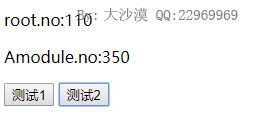当项目非常大时,如果所有的状态都集中放到一个对象中,store 对象就有可能变得相当臃肿。
为了解决这个问题,Vuex允许我们将 store 分割成模块(module)。每个模块拥有自己的 state、mutation、action、getter、甚至是嵌套子模块——从上至下进行同样方式的分割。
namespaced表示当前模块是否使用命名空间,如果使用的话,那么设置了namespaced属性的模块将和其它模块独立开来,调用时得指定命名空间后才可以访问得到
例如:
DOCTYPE html>
<html lang="en">
<head>
<meta charset="UTF-8">
<title>Documenttitle>
<script src="https://cdn.jsdelivr.net/npm/[email protected]/dist/vue.js">script>
<script src="./vuex.js">script>
head>
<body>
<div id="app">
<p>count:{{count}}p>
<p>Acount:{{Acount}}p>
<button @click="test1">测试1button>
<button @click="test2">测试2button>
div>
<script>
const moduleA ={ //子仓库a
state:{count:0},
mutations:{Aincrement(state){state.count++}},
actions:{Aincrement(context){context.commit('Aincrement')}}
}
const store = new Vuex.Store({ //创建Store实例
modules:{A:moduleA},
state:{count:1},
mutations:{increment(state){state.count++}},
actions:{increment(context){context.commit('increment')}}
})
new Vue({ //创建Vue实例
el:"#app",
store, //把实例化后的store作为new Vue的一个参数
computed:{
...Vuex.mapState(['count']),
...Vuex.mapState({Acount:state=>state.A.count})
},
methods:{
...Vuex.mapActions(['increment','Aincrement']),
test1(){
this.increment();
},
test2(){
this.Aincrement();
}
}
})
script>
body>
html>
我们在根仓库定义了count状态,在子仓库A也定义了一个count,然后渲染如下:
点击测试1按钮将触发根仓库的increment这个action,点击按钮2将触发子仓库A的Aincrement这个action,分别给当前仓库的count递增1
像上面例子里区分的子module,它的mutations和actions都是和根仓库的等级是一样的,如果子仓库和根仓库的mutation或者action重名了,那么就会合并为一个数字,当触发时都会执行,例如:
DOCTYPE html>
<html lang="en">
<head>
<meta charset="UTF-8">
<title>Documenttitle>
<script src="https://cdn.jsdelivr.net/npm/[email protected]/dist/vue.js">script>
<script src="https://unpkg.com/[email protected]/dist/vuex.js">script>
head>
<body>
<div id="app">
<p>root.no:{{no}}p>
<p>Amodule.no:{{Ano}}p>
<button @click="test">测试1button>
div>
<script>
const store = new Vuex.Store({
state:{no:100},
mutations:{
increment(state,no){state.no+=no;}
},
modules:{
A:{
state:{no:50},
mutations:{
increment(state,no){state.no+=100;}
}
}
}
})
var app = new Vue({
store,
computed:{
...Vuex.mapState({no:state=>state.no,Ano:state=>state.A.no})
},
methods:{
...Vuex.mapMutations(['increment']),
test(){
this.increment(10);
}
},
el:'#app'
})
script>
body>
html>
我们点击测试1按钮时将触发根仓库和子仓库A的increment这个mutation,此时页面会将两个对应的no都分别进行更新,这样是不符合逻辑的,最好每个仓库都互不干扰
writer by:大沙漠 QQ:22969969
我们可以给子仓库定义一个namespaced属性,值为true,表示开启命名空间,这样,各个仓库间的mutation、getter就不会有冲突了,例如:
DOCTYPE html>
<html lang="en">
<head>
<meta charset="UTF-8">
<title>Documenttitle>
<script src="https://cdn.jsdelivr.net/npm/[email protected]/dist/vue.js">script>
<script src="https://unpkg.com/[email protected]/dist/vuex.js">script>
head>
<body>
<div id="app">
<p>root.no:{{no}}p>
<p>Amodule.no:{{Ano}}p>
<button @click="test1">测试1button>
<button @click="test2">测试2button>
div>
<script>
const store = new Vuex.Store({
state:{no:100},
mutations:{
increment(state,no){state.no+=no;}
},
modules:{
A:{
namespaced:true,
state:{no:50},
mutations:{
increment(state,no){state.no+=no;}
}
}
}
})
var app = new Vue({
el:'#app',
store,
computed:{
...Vuex.mapState({no:state=>state.no,Ano:state=>state.A.no})
},
methods:{
...Vuex.mapMutations(['increment']),
...Vuex.mapMutations('A',{incrementA:'increment'}),
test1(){
this.increment(10);
},
test2(){
this.incrementA(100);
}
}
})
script>
body>
html>
渲染如下:
这里虽然子仓库和根仓库都定义了increment,但是因为子仓库定义了namespaced,所以两个并不会起冲突,namespaced的作用就是将mutation和action和其它模块区分开来,引用时需要指定命名空间才可以
源码分析
module的收集是在Vuex.store()实例化时执行ModuleCollection.register()时完成的,如下:
ModuleCollection.prototype.register = function register (path, rawModule, runtime) { //收集模块 /*略*/ // register nested modules if (rawModule.modules) { //如果rawModule.modules存在(含有子仓库) forEachValue(rawModule.modules, function (rawChildModule, key) { this$1.register(path.concat(key), rawChildModule, runtime); //递归调用register()注册子仓库 }); } };
这样就完成了模块的收集,安装模块时也会对子模块进行判断,如下:
function installModule (store, rootState, path, module, hot) { //安装模块 /*略*/ module.forEachChild(function (child, key) { //如果有子模版 installModule(store, rootState, path.concat(key), child, hot); //则递归调用自身 }); }
这样就完成模块的安装了。

